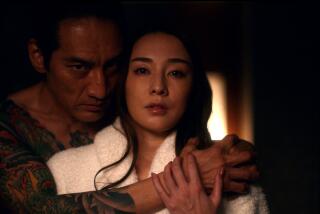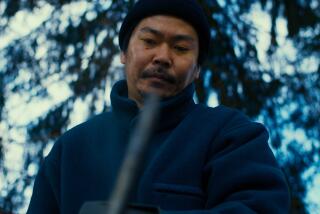Film Tribute Features Mizoguchi’s Best
- Share via
Director Kenji Mizoguchi stands alongside Yasujiro Ozu and Akira Kurosawa as one of the touchstones of Japanese cinema, their internationally respected films playing a major part in the revival of their nation’s film industry following World War II. Mizoguchi, whose career began in the 1920s, rose to prominence when three of his films won top prizes at the Venice Film Festival in consecutive years (1952-54).
The Los Angeles County Museum of Art Film Department pays tribute to him this weekend with “Spotlight on Mizoguchi,” featuring two of the director’s Venice triumphs, “Ugetsu” and “The Life of Oharu.”
Mizoguchi, who died in 1956, embraced many styles of filmmaking during his nearly 40-year career, from historical dramas and literary adaptations to modern, near neo-realistic stories told in urban settings. The films he made in the ‘30s often focused on the inequalities suffered by women in Japanese culture, most notably in his 1936 film “Osaka Elegy,” a melodrama about an oppressed Tokyo telephone operator. In “Osaka,” Mizoguchi used dark shadows similar to the later Hollywood style found in film noir.
Unlike Kurosawa, whose early films made him an international critics’ favorite, Mizoguchi had made more than 60 films before being discovered by cineastes. The director’s 1952 film, “The Life of Oharu,” which screens Saturday at 7:30 p.m. in LACMA’s Bing Theater, won the International Award at Venice and earned him worldwide prominence. The film tells the story of a prostitute in 17th century feudal Japan recounting her troubled life as she prays to a statue of Buddha. Its long takes and celebrated performance by Kinuyo Tanaka, as Oharu, evokes a transcendental style central to Mizoguchi’s final films.
“Ugetsu,” screening Friday at 7:30 p.m., won the Silver Lion at Venice the following year and is regarded as Mizoguchi’s masterpiece. Based on a pair of short stories by 18th century writer Akinari Ueda, the fable-like film looks at two men, a country potter and a farmer, whose dreams destroy those around them, and displays the fluid camerawork for which Mizoguchi is known.
More to Read
Only good movies
Get the Indie Focus newsletter, Mark Olsen's weekly guide to the world of cinema.
You may occasionally receive promotional content from the Los Angeles Times.











